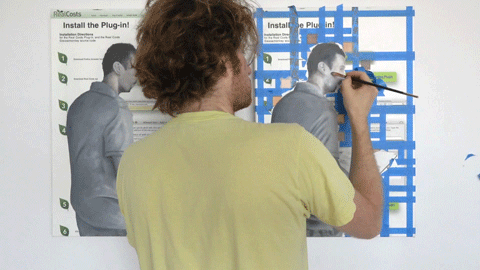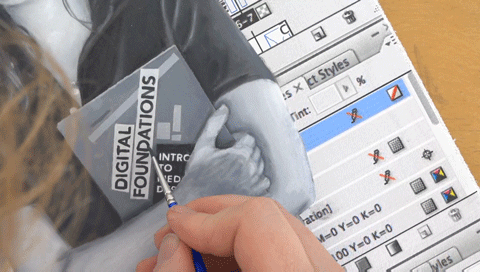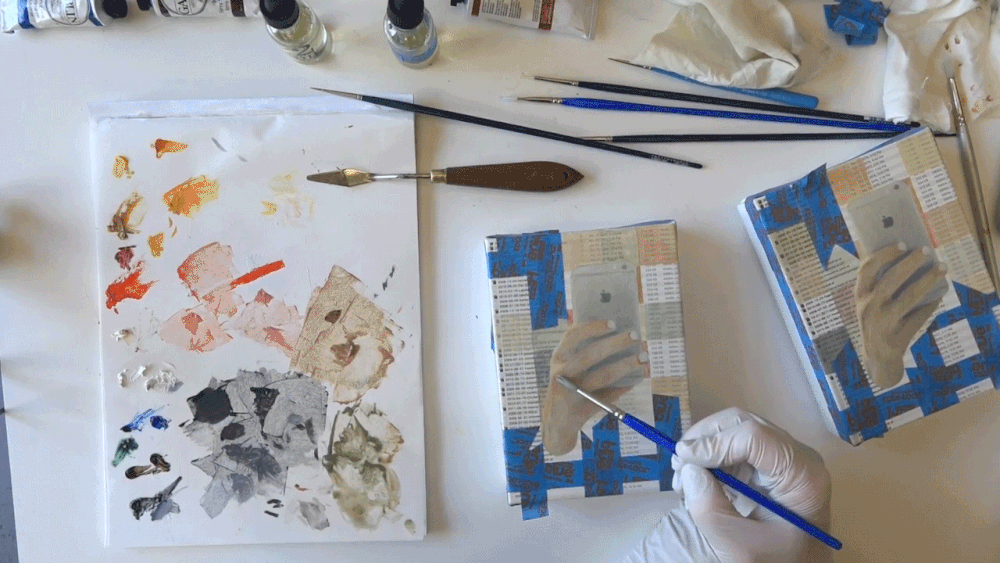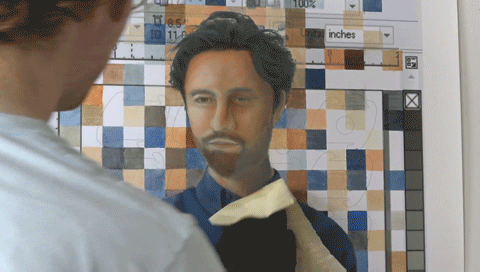Watch an Artist Paint Every Assistant They’ve Ever Had
By: Casey Lesser, Jul 30, 2019

Michael Mandiberg, Live Study , 2019. Courtesy of the artist.
A lone painter agonizes over a canvas, working into the wee hours of the night. Such mythologized visions of artists have been widely popularized, but hardly reflect reality. In truth, many artists, particularly those at the top of their game, work like any other highly skilled professionals, with defined work hours, methodical processes, and the support of assistants.
Artist Michael Mandiberg is showing what it means to work as an artist today with their latest work, Live Study (2019–ongoing) The project, which was commissioned by the Whitney Museum and is featured on their, as well as YouTube and Instagram, offers a livestream of the artist’s studio as they paint portraits of the 60 or so assistants they’ve had over the past 15 years. In doing so, Mandiberg offers a window into their practice, and spotlights the many, many hours of work that assistants contribute.
“I’m making this labor visible, this hidden labor that no one wants to talk about,” Mandiberg explained over the phone. They described recently visiting a major artist’s studio, which was a hive of activity, with seven full-time assistants. “Most artists who are in that mode really don’t want anyone to know that and don’t want to talk about it. And they don’t want people to know that they don’t paint their paintings.”
Mandiberg, who has two degrees in photography, is essentially learning to paint as they embark on a yearslong project that will see them create around 100 paintings over the course of thousands of hours. And it will all be captured on video.
The idea came about while the artist was working on a 2016–17 piece, Quantified Self Portrait (One Year Performance), part of a LACMA Art & Technology grant. Mandiberg tracked all of their time with Quantified Selftools, developed custom software that took photographs and screenshots every 15 minutes, and made a video out of that material. While editing, they were intrigued by how frequently other people appeared in the footage or in front of their computer screen.

Michael Mandiberg, Live Study, 2019. Courtesy of the artist.
“I started to think about making a history painting of the studio, thinking of Courbet and ,” Mandiberg offered. “Those big, grand scenes that showed the work itself being made—but are ultimately about cultivating the myth of genius. I’m trying to find a way of deconstructing that, in the process of representing process.”
The fact that Mandiberg is not a painter is key to the project and to deconstructing that myth. “There are a lot of things that I’m not formally trained in that I do, like design and programming and teaching and digital media,” Mandiberg said. “A lot of this has been going back to ways of learning that process.” They’ve been using YouTube video tutorials and gleaning advice from friends who are painters. As you watch the livestream, you can hear Mandiberg verbalizing their inner monologue, telling the audience about their process, but also pointing out mistakes and the things they’re struggling with—be that mixing a color or painting someone’s face.

Michael Mandiberg, Live Study, 2019. Courtesy of the artist.
Preparations for Live Study began over a year ago. Mandiberg asked their former assistants to share an image of themselves from the time they worked together. Each painting features that image, and has a custom size and composition based on the work they did for the artist: one hour of work equals roughly one square inch of canvas. Each background shows a screenshot of the digital work they did, and anything physical they produced for the artist appears in their hands. Mandiberg is making two of each painting—one to keep and one to give the assistant as a gift.
At the time of speaking, Mandiberg was painting logo designer Evan Moran, who worked with the artist over a decade ago; the backdrop of the painting shows an interface Moran designed for the Mandiberg’s project The Real Costs (2006), and he holds a book of logo mock-ups in his hands.

Michael Mandiberg, Live Study , 2019. Courtesy of the artist.
Mandiberg creates the compositions on Photoshop, then prints them onto the canvas. The works are digital-analog hybrids, like much of the artist’s practice. Mandiberg is perhaps best known for Print Wikipedia (2009–16), for which they printed all of Wikipedia and bound it into books. Other notable projects include FDIC Insured (2008–16), an installation of 527 discarded investment self-help books, their covers burned with logos of failed banks. And, among many other projects, Mandiberg is a co-founder of Art+Feminism.
Many of the early assistants, like Moran, were students that the artist hired as a professor at the College of Staten Island. The portraits also include people who worked with the artist after they were diagnosed with cancer in 2008. “The next three to four years were about disability, and not being able to do things, because I was really sick,” Mandiberg reflected. “So it becomes about caregiving in a way, and support.”
The more recent group of assistants came after the artist recovered, and as their career ramped up around the launch of Print Wikipedia in 2015, and other time-intensive projects that followed. “I really couldn’t get done everything that was being asked of me,” Mandiberg said.

Michael Mandiberg, Live Study , 2019. Courtesy of the artist.
At the time of speaking, Mandiberg was some 50 hours into the project. “I find that this kind of work, I can’t do for more than five hours at a time, because it requires such physical and mental concentration—and I am learning, right?” they said, nodding to the exhausting process of painting while observing and critiquing their technique.
Mandiberg will inevitably improve as a painter over the course of the project. But it’s uncertain how long that it all will take—they suggested it could be as many as 5,000 hours. This uncertainty is also reflective of how artists work, and the many projects, commitments, and administrative work they juggle.
“I’m okay with not knowing the exact parameters going into it, just knowing that it’s going to be significant,” Mandiberg reflected. “I’m not intimidated by saying I’m going to spend the next five years working on this project if that’s what it takes. That’s what I do. That’s the way that I’ve learned how to work.”
Casey Lesser is Artsy’s Lead Editor, Contemporary Art and Creativity.
